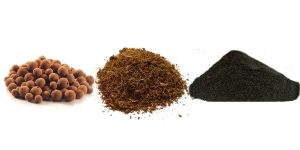Plant Nutrition
The questions are how, when and what to feed your plants from seedling to full maturity. These decisions are largely made by the plants you choose and what nutrients they need at the different stages of their growth.
You will often find on many review and manufacturer sites(as well as forums) the term ‘explosive growth’ . This can lead the beginner to the conclusion, that ‘more is more’, but this is very often misunderstood and in many cases wrong. An understanding of what nutrients a plant needs, what combinations and concentrations are vital. So, before considering adding more nutrients and additives to your growing environment consider the Law of Limiting Factors! What this law states is that a plant’s performance is affected not by the most abundant resource, but by the most deficient one. Essentially, a plant will only yield as much as the least available nutrient allows. To muddy the waters, excessive amounts of certain nutrients can prohibit the uptake of other nutrients.
The attraction of dumping a load of a product into a system hoping for a boost is something, we at Addloes have often come across. But ultimately, one the most difficult skills for a grower to develop is correctly identifying the real ‘limiting factors’ of growth. This ability develops as a function of acquiring technical knowledge and paying close attention to the performance of plants before and after additions and treatments. Luckily, to help you through this ‘minefield’ of possibiliies, we at Addloes aim to provide the essential knowledge you need(withover 20 years in the growing business) to get the highest yields from your plants.
When you consider all the other factors involved in plant growth, including light intensity, temperature, humidity, air flow, CO2 levels, pH and EC values, the grower soon comes to realise that ideal growing conditions(to maximise plant growth from seed to maturity) take a good deal of consideration, trial and error.
Don’t worry, we are here to help and advise!
Here’s a few general pointers on media, nutrients and additives.
Growing Media
Growing media is an essential part of a plant’s growing environment. There are many types of growing media available, each offering different advantages. Essentially, a growing media is a soil substitute. The media are all sterile substrates that have excellent aeration properties.
For germinating seeds, rockwool cubes or jiffy pellets are excellent starting media. Seedlings and cuttings can be transplanted into larger rockwool cubes or slabs and then into a hydroponic system or other gowing systems, using media such as soil, soil mixes and coco.

In a wide range of hydroponic systems(such as flood and drain, drip irrigation etc), clay pebbles are by far the most popular potting-on media. and it’s not hard to see why, as they offer great pH stability, excellent aeration and are re-usable. Take a look at our range of media options, here.

Nutrients
Plants need nutrients in order to grow and develop. Nutrients come in various forms with various job roles and can be organic or mineral. As a general rule, a base nutrient is needed for the main stages of a plant’s growth and provide essential macronutrients and often secondary and micronutrients. In order to promote vigorous plant growth and increase yields, added nutrients provide more of the essential minerals a plant needs on top of what it gets from the growing medium.
Here’s a breakdown of some of the essential minerals/elements needed for strong plant growth –
Primary macronutrients – nitrogen (N), phosphorus (P), potassium (K)
Secondary macronutrients – calcium (Ca), sulphur (S), magnesium (Mg)
Micronutrients/trace minerals – boron (B), chlorine (Cl), manganese (Mn), iron (Fe), zinc (Zn), copper (Cu), molybdenum (Mo), nickel (Ni)
Other elements such as Silicon(Si), in soluble form, offer extra benefits, such as aiding the plant’s ability to fight stress, help prevent powdery mildew and increase the uptake of many micronutrients by a plant’s roots.
Canna gives some very useful information on the interactions of nutrients.
What to add and when is very much dependant on the variety of plant and at what stage of it’s lifecycle it’s in. Finding the right balance means doing your research to find out as much as you can and of course seek good advice. Be careful, because you can get it wrong but at the same remember, failure can often be the best form of learning!
An element present at a low level may cause deficiency symptoms, while the same element at a higher level may cause toxicity and it’s important to know and understand the symptoms of each and adjust feeding accordingly. The Canna Deficiency Guide, gives some examples of the tell-tale signs of element deficiencies.
An important part of nutrient absorption by your plants is the pH level of the media you grow in. pH neutral is 7, but most plants thrive in a slightly acidic environmental as nutrient availability is highest in those conditions.
Have a look at this helpful pH graph showing the nutrients and their availability at different pH levels.
Have a look at our nutrients section for our ranges of manufacturers’ products.
Additives
Additives are used for more specific purposes such as root development, vegetative growth and bloom enhancement. See our additives section for our ranges of manufacturers’ products designed and developed for the specific needs of your plants at different growth stages. Each additive product description comes complete with the details of the benefits of using the product correctly. To help with manufacturers recommended guidelines have a look at the Nutrient feed charts and guides section.





